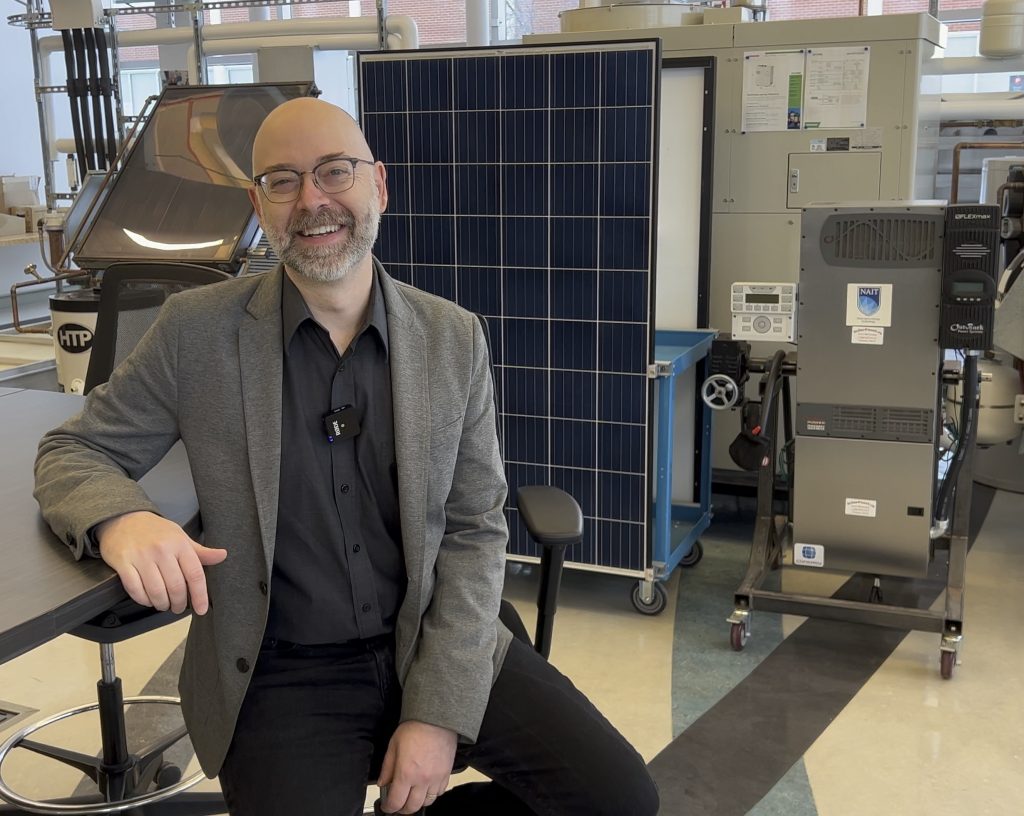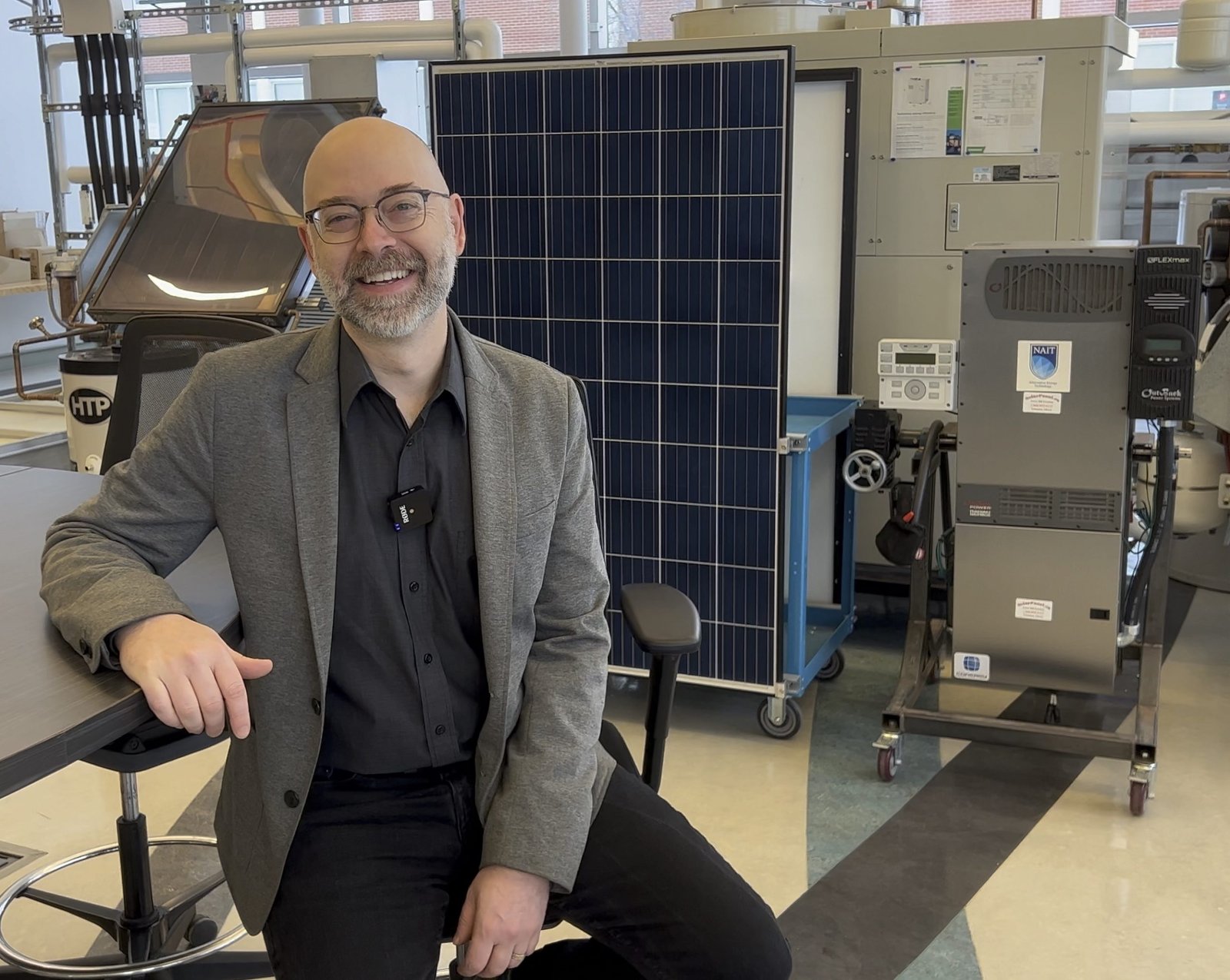By David Dodge, GreenEnergyFutures.ca
As NAIT’s Alternative Energy program turns 10, we sit down with Dr. Jim Sandercock to discuss the evolution of the program, its students and the renewable energy revolution that’s happened in that same decade. In our Green Energy Futures CKUA Radio podcast Sandercock says when the program, based in Edmonton, Alberta began 10 years ago the focus was solar thermal systems (hot water), not solar photovoltaics (electricity). And “Everybody was talking about the hydrogen economy in 2010 when we were doing the paperwork to start our program up. And then that kind of just fell right off the cliff for a decade,” says Sandercock.
Solar thermal too fell off a cliff, at least in northern climates where solar PV now dominates.

“Ten years later, the cost of solar PV has dropped by 90%. And, and the cost of batteries has dropped by about 90% as well. And so the entire industry bedrock of what we we’re training our students [to do] has just gone through this unbelievable amount of evolution.”
The NAIT program has alway attracted a diversity of students that have an average age of between 26 and 28 years-old. Some have trades already, others have degrees and some come straight out of high school.
“I’d say roughly three quarters of our student body is transitioning from a former degree, or career and is moving into the clean energy sector,” says Sandercock. About 20% are transitioning from oil and gas.
“In our early years we had a lot of women in the program, I’d say about 30%. And for some reason that’s really declined,” says Sandercock. He says here’s a “shout out” if you are looking for new opportunities.
As most students have told us the program is very comprehensive and it is definitely not easy. In their final year students do a capstone project that solves a real-world problem in a real world project.
“Brandon Sandmier came out of our program and based on his capstone (working on energy auditing), he and a peer within our program started their own (solar and energy auditing) company, got bought out, and Brandon has moved on to become the energy specialist for Sturgeon County” near Edmonton.
Indeed in the early years some students had difficulties finding work. Industry didn’t know what to make of these new young engineering technologists in the emerging clean energy market.
Today students are bringing desperately needed expertise to the market, starting companies and fuelling the clean energy market.
Rae Anne Wadey was in the first graduating class almost a decade ago. She struggled to find work initially and eventually wound up working for a solar company after pestering them at a worksite in her home town of Edson, Alberta.
She soon realized stacking a trade on her engineering technology diploma would be beneficial. As a young woman, this too proved challenging. But she managed to apprentice as an electrician and things took off from there. She wound up working on some of the most iconic solar projects in Alberta and today she’s teaching in NAIT’s Alternative Energy program.
Clean Energy’s Evolving Landscape
Solar and wind power were always mainstays of the NAIT program and the markets for both are booming today. But as Sandercock notes hydrogen fell off a cliff and now it’s back.
Initially NAIT taught students how to design and install solar systems, but a few years ago it became apparent expertise was desperately needed to help with operations, maintenance and commissioning so the program evolved to incorporate these elements.
Then about four years ago “One of our staff said what’s really going to matter is energy auditing,” says Sandercock. So they added energy auditing and energy management planning to the program.
“We realized that by the time we get to 2050 when we want to be net-zero as a country, 80% of the housing stock will have already been built and will not be net-zero,” says Sandercock.
It became apparent putting solar on roofs wasn’t enough. So NAIT developed courses in deep energy retrofits and microgrids to integrate solar, battery storage and high performance buildings into the systems of the future.
The Future is Sunny
People have long talked about diversifying Alberta’s oil and gas dependent economy and although there are probably no new industries as lucrative we may be reaching an inflection point for clean energy says Sandercock.
The Travers 465 megawatt solar project is well over half a billion dollars in investment by itself and there are more than a dozen other significant projects underway. “We’re talking about a very significant industry,” says Sandercock.
Then you have companies and nations creating their own plans to reach net-zero which is creating major new markets for retrofitting buildings, building new energy systems and even helping businesses with ESG reporting.
Deploy, Deploy, Deploy
“People get hung up asking how is this transition going to happen and how do we get to net-zero? How do we get to 100% renewables powering our systems whether it’s heating and cooling our buildings or powering our plugs?” says Sandercock.
They get hung up on the idea that we have to solve it today, but what we need to do is deploy, says Sandercock.
“Many of these challenges are going to be solved over the next 30 or 40 years, the thing we need to do today is deploy, deploy, deploy,” says Sandercock.
And that’s how costs will continue to drop because the stuff we are putting out there in the renewable energy space are just commodities and they are getting cheaper, he says.
That’s where the jobs are and where the future will be.
Ironically NAIT’s Alternative Energy program starting by training people in what looked like cutting edge technologies at the time. Today as they graduate their 200th student, the market could use many more students than they can train.

